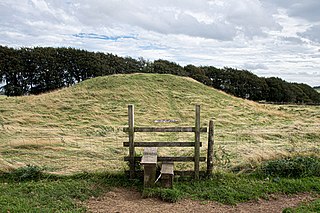| Heath Wood barrow cemetery | |
|---|---|
 The south-east entrance to Heath Wood | |
| Location | Ingleby, Derbyshire |
| Coordinates | 52°49′41″N1°29′24″W / 52.828°N 1.490°W |
| Built | 9th Century AD |
Heath Wood barrow cemetery is a Viking burial site near Ingleby, Derbyshire.
| Heath Wood barrow cemetery | |
|---|---|
 The south-east entrance to Heath Wood | |
| Location | Ingleby, Derbyshire |
| Coordinates | 52°49′41″N1°29′24″W / 52.828°N 1.490°W |
| Built | 9th Century AD |
Heath Wood barrow cemetery is a Viking burial site near Ingleby, Derbyshire.
Heath Wood contains a series of 59 barrows which is a Viking burial site near Ingleby, Derbyshire. The barrows are unusual because they are the only known Scandinavian cremation site in the British Isles. [1] It is believed to be a war cemetery of the Viking Great Army which arrived in the area in 873 A.D. Early excavations by Thomas Bateman in May 1855 found that some of the mounds were empty cenotaph mounds where presumably the body was not available. [2]
Excavations between 1998 and 2000 produced a number of finds which are available in Derby Museum. It is believed that these remains are from the same period as burials discovered in nearby Repton. However, the Repton burials are not cremations. This wood is currently leased by the Forestry Commission from the Church Commissioners and it is designated "Derbyshire 101" as a Scheduled Ancient Monument. [1] [3]

The path that goes through the wood links Foremarke Hall with Knowle Hill which are two properties previously owned by the Burdett family together with the land belong to Heath Wood. Presumably, the path was useful when the family moved to Knowle Hill whilst building work was in progress in order to visit St Saviour's church which the family built in 1662. In the eighteenth century Heath Wood was actually a field and the growth of woodland has only happened since then. Without the woods being there then this burial place would have had a fine view of the Trent valley. The path that goes through the woods neatly misses any of the ancient barrows and it is believed that no barrows were removed to ease its path. [1]
Repton is a village and civil parish in the South Derbyshire district of Derbyshire, England, located on the edge of the River Trent floodplain, about 4+1⁄2 miles (7 km) north of Swadlincote. The population taken at the 2001 census was 2,707, increasing to 2,867 at the 2011 census. Repton is close to the county boundary with neighbouring Staffordshire and about 4+1⁄2 miles (7 km) northeast of Burton upon Trent.

A tumulus is a mound of earth and stones raised over a grave or graves. Tumuli are also known as barrows, burial mounds or kurgans, and may be found throughout much of the world. A cairn, which is a mound of stones built for various purposes, may also originally have been a tumulus.

Arbor Low is a well-preserved Neolithic henge in the Derbyshire Peak District, England. It lies on a Carboniferous Limestone plateau known as the White Peak area. The monument consists of a stone circle surrounded by earthworks and a ditch.

Thomas Bateman was an English antiquary and barrow-digger.

A round barrow is a type of tumulus and is one of the most common types of archaeological monuments. Although concentrated in Europe, they are found in many parts of the world, probably because of their simple construction and universal purpose.

Norse funerals, or the burial customs of Viking Age North Germanic Norsemen, are known both from archaeology and from historical accounts such as the Icelandic sagas and Old Norse poetry.

Foremarke Hall is a Georgian-Palladian country house and manor house. Completed in 1762, the Hall is located at the manor (hamlet) of Foremark, near the hamlets of Ingleby, Ticknall, Milton, and the village of Repton in South Derbyshire, England.

Hob Hurst's House is a Bronze Age barrow on Beeley Moor near Bakewell in Derbyshire. It is unique in that instead of the normal round shape, Hob Hurst's barrow is rectangular. Originally made with 13 stones, only five remain today.

Doll Tor is a stone circle located just to the west of Stanton Moor, near the village of Birchover, Derbyshire in the English East Midlands. Doll Tor is part of a tradition of stone circle construction that spread throughout much of Britain, Ireland, and Brittany during the Late Neolithic and Early Bronze Ages, over a period between 3300 and 900 BCE. The purpose of such monuments is unknown, although archaeologists speculate that the stones represented supernatural entities for the circles' builders.

Ingleby is a hamlet and civil parish in South Derbyshire, England, situated to the south of the River Trent on a rise between Stanton by Bridge and Repton.

Garboldisham is a village and civil parish in the English county of Norfolk. The village is located 7.1 miles (11.4 km) north-west of Diss and 22 miles (35 km) south-west of Norwich, along the A1066 between Thetford and Scole.
The archaeology of Anglo-Saxon England is the study of the archaeology of England from the 5th century AD to the 11th century, when it was ruled by Germanic tribes known collectively as the Anglo-Saxons.

The Taplow Barrow is an early medieval burial mound in Taplow Court, an estate in the south-eastern English county of Buckinghamshire. Constructed in the seventh century, when the region was part of an Anglo-Saxon kingdom, it contained the remains of a deceased individual and their grave goods, now mostly in the British Museum. It is often referred to in archaeology as the Taplow burial.
Repton Abbey was an Anglo-Saxon Benedictine abbey in Derbyshire, England. Founded in the 7th century, the abbey was a double monastery, a community of both monks and nuns. The abbey is noted for its connections to various saints and Mercian royalty; two of the thirty-seven Mercian Kings were buried within the abbey's crypt. The abbey was abandoned in 873, when Repton was overrun by the invading Great Heathen Army.
Burial in Anglo-Saxon England refers to the grave and burial customs followed by the Anglo-Saxons between the mid 5th and 11th centuries CE in Early Mediaeval England. The variation of the practice performed by the Anglo-Saxon peoples during this period, included the use of both cremation and inhumation. There is a commonality in the burial places between the rich and poor – their resting places sit alongside one another in shared cemeteries. Both of these forms of burial were typically accompanied by grave goods, which included food, jewelry, and weaponry. The actual burials themselves, whether of cremated or inhumed remains, were placed in a variety of sites, including in cemeteries, burial mounds or, more rarely, in ship burials.

Gib Hill is a large burial mound in the Peak District, Derbyshire, England. It is thought to be a Neolithic oval barrow with an Early Bronze Age round barrow superimposed at one end. It is located some 300 metres south-west of Arbor Low henge.

Five Wells is a Neolithic chambered tomb between the villages of Chelmorton and Taddington on Taddington Moor in the Derbyshire Peak District in England.

Benty Grange is a Site of Special Scientific Interest in the parish of Monyash in Derbyshire, England. 21.1 ha in size and with at least four species of grass and ten others of plant, it is considered of national importance as one of the largest areas of unimproved species-rich neutral lowland grassland in the Peak District National Park. The area was confirmed as a Site of Special Scientific Interest on 8 March 2013, following notification of the designation on 19 June 2012.

This is a list of scheduled monuments in the district of South Derbyshire in the English county of Derbyshire.

Micah Salt was a tailor and amateur archaeologist from Buxton in Derbyshire.